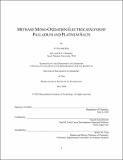| dc.contributor.advisor | Yogesh Surendranath. | en_US |
| dc.contributor.author | Kim, R. Soyoung(Rebecca Soyoung) | en_US |
| dc.contributor.other | Massachusetts Institute of Technology. Department of Chemistry. | en_US |
| dc.date.accessioned | 2020-09-15T21:57:31Z | |
| dc.date.available | 2020-09-15T21:57:31Z | |
| dc.date.copyright | 2020 | en_US |
| dc.date.issued | 2020 | en_US |
| dc.identifier.uri | https://hdl.handle.net/1721.1/127430 | |
| dc.description | Thesis: Ph. D., Massachusetts Institute of Technology, Department of Chemistry, May, 2020 | en_US |
| dc.description | Cataloged from the official PDF of thesis. | en_US |
| dc.description | Includes bibliographical references. | en_US |
| dc.description.abstract | Selective oxidation of methane to methanol would enable better utilization of natural gas resources. Many homogeneous metal ions activate methane under mild conditions, but turning this reactivity into catalysis requires a viable oxidation step. Electrochemistry offers unique advantages in this regard, and this thesis demonstrates two mechanistically distinct approaches for methane functionalization electrocatalysis. Following the first approach, a novel high-valent Pd complex with exceptional methane functionalization reaction rates is electrochemically generated in fuming sulfuric acid. We present a structural model of this complex as a Pd[superscript III] dimer with a Pd-Pd bond and a 5-fold O-atom sulfate/bisulfate coordination environment at each Pd atom. We also discover, using EPR spectroscopy, a mixed-valent Pd₂[superscript II][superscript III] complex in the electrochemical oxidation sequence. | en_US |
| dc.description.abstract | From these and redox potential measurements, a comprehensive thermodynamic landscape for the oxidation of Pd[superscript II] to Pd[superscript III]₂ emerge for the first time, and the critical role of M-M and M-L bonding in driving the electrochemical self-assembly of Pd[superscript III]₂ is exposed. Building on these structural studies, we arrive at a mechanistic model for methane functionalization by Pd[superscript III]₂ that simultaneously yields methyl bisulfate (MBS) and methanesulfonic acid (MSA). Rate-limiting H atom abstraction by Pd[superscript III]₂ and product bifurcation from the methyl radical intermediate is proposed based on experimentally determined rate laws and observations with radical scavengers and initiators. DFT calculations likewise support a shared outer-sphere proton-coupled electron transfer (PCET) reaction for the generation of both products. | en_US |
| dc.description.abstract | Following the second approach for methane functionalization electrocatalysis, we establish an electrochemical solution to the long-standing oxidant problem of Shilov's Pt[superscript II] catalyst. Inner-sphere electron transfer facilitates the electrochemical oxidation of Pt[superscript II] to Pt[superscript IV] on Cl-adsorbed platinum electrodes without concomitant methanol oxidation. The favorable catalytic property of this electrode is exploited for the continuous regeneration of the Pt[superscript IV] oxidant during Pt[superscript II]-catalyzed methane functionalization. The critical Pt[superscript II]/[superscript IV] ratio is maintained via dynamic modulation of the electric current and in situ monitoring of the solution redox potential. Thereby, we show stable and sustained turnover of Shilov's catalyst for the first time. | en_US |
| dc.description.statementofresponsibility | by R. Soyoung Kim. | en_US |
| dc.format.extent | 171 pages | en_US |
| dc.language.iso | eng | en_US |
| dc.publisher | Massachusetts Institute of Technology | en_US |
| dc.rights | MIT theses may be protected by copyright. Please reuse MIT thesis content according to the MIT Libraries Permissions Policy, which is available through the URL provided. | en_US |
| dc.rights.uri | http://dspace.mit.edu/handle/1721.1/7582 | en_US |
| dc.subject | Chemistry. | en_US |
| dc.title | Methane mono-oxidation electrocatalysis by palladium and platinum salts | en_US |
| dc.type | Thesis | en_US |
| dc.description.degree | Ph. D. | en_US |
| dc.contributor.department | Massachusetts Institute of Technology. Department of Chemistry | en_US |
| dc.identifier.oclc | 1192965695 | en_US |
| dc.description.collection | Ph.D. Massachusetts Institute of Technology, Department of Chemistry | en_US |
| dspace.imported | 2020-09-15T21:57:30Z | en_US |
| mit.thesis.degree | Doctoral | en_US |
| mit.thesis.department | Chem | en_US |
